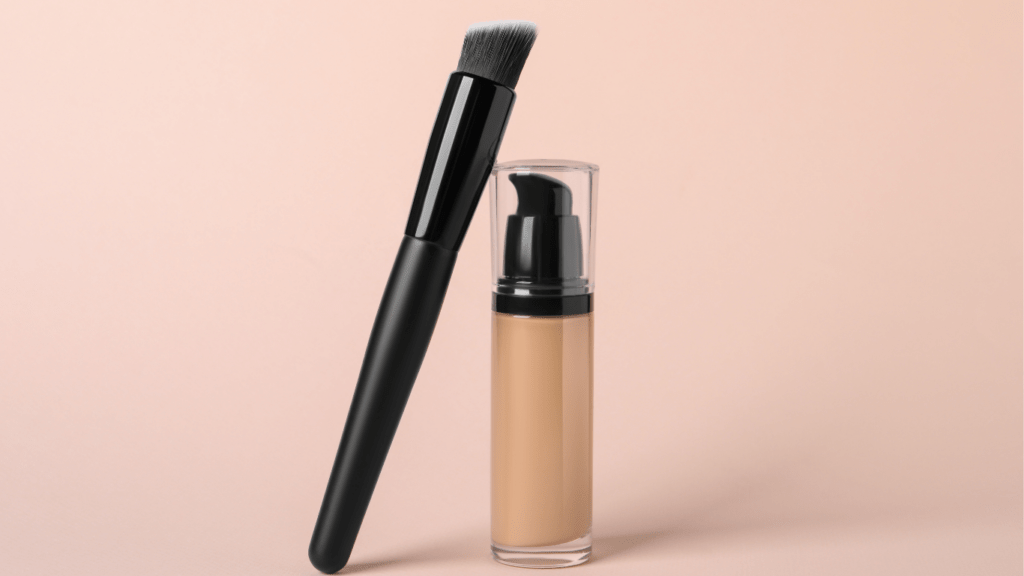Understanding Skin Types
Identifying your skin type is the first step in choosing the right foundation. Different foundations work best with specific skin characteristics.
Oily Skin
Oily skin often appears shiny, especially in the T-zone (forehead, nose, and chin). I’ve noticed that matte foundations, which typically contain oil-absorbing ingredients, work best. Look for keywords like “oil-free” and “long-wear” on the packaging. These products help reduce excess shine and provide a smooth finish.
Dry Skin
Dry skin may feel tight or rough, often flaking in certain areas. Hydrating foundations with a dewy finish suit this type. They often contain moisturizing agents like hyaluronic acid and glycerin. I recommend seeking products labeled “hydrating” or “moisturizing” to ensure your skin remains well-hydrated throughout the day.
Combination Skin
Combination skin features both oily and dry areas, usually oily in the T-zone and dry on the cheeks. A balanced foundation formula works best here. I find lightweight, buildable foundations effective for this type, allowing for extra coverage on oily areas and light application on dry patches. Products advertised as “balanced” or “adaptive” cater to these needs.
Sensitive Skin
Sensitive skin often reacts to various ingredients, displaying redness, itching, or irritation. Hypoallergenic foundations, which are free from common irritants like fragrance and parabens, are ideal. When selecting a foundation, I advise looking for “dermatologist-tested” or “non-comedogenic” labels to minimize potential skin reactions.
Types of Foundations
Choosing the right foundation starts with understanding the different types available. Each type offers unique benefits and can suit various skin types and conditions.
Liquid Foundation
Liquid foundations provide versatility in coverage, from sheer to full. These foundations work for most skin types (oily, dry, combination, sensitive). For oily skin, oil-free formulas help control shine. Dry skin benefits from hydrating ingredients like hyaluronic acid. Combination skin requires balancing formulas. Sensitive skin needs gentle formulations free from irritants.
Powder Foundation
Powder foundations offer a lightweight texture and help reduce shine. These are ideal for oily or combination skin as they absorb excess oil. Mineral powder foundations are suitable for sensitive skin since they contain fewer irritants. They’re easy to apply and provide buildable coverage, making them convenient for touch-ups throughout the day.
Cream Foundation
Cream foundations deliver a rich, moisturizing finish, ideal for dry or mature skin. They provide medium to full coverage and can camouflage skin imperfections. These foundations offer a dewy look but can feel heavy on oily skin. Their moisturizing properties help maintain hydrated skin throughout the day.
Stick Foundation
Stick foundations provide convenience and portability, great for on-the-go applications. They offer buildable coverage and work for combination to dry skin types. These foundations can double as concealers, making them versatile. However, those with oily skin might find them too thick. Always choose a formula that matches your skin type to avoid unwanted shine or dryness.
Understanding these foundation types helps make an informed choice based on your skin’s needs and your desired finish.
Selecting Foundations Based on Skin Type

Choosing the right foundation involves identifying your skin type and understanding which formula suits it best.
Best Foundations for Oily Skin
Foundations for oily skin need to control shine and reduce excess oil. I recommend using powder foundations and oil-free liquid foundations. Powders help absorb oil, providing a matte finish. Oil-free liquids prevent extra oil production, keeping makeup in place longer. For example, formulations labeled “matte” or “oil-control” serve well.
Best Foundations for Dry Skin
Dry skin benefits from hydrating foundations. Cream and liquid foundations with moisturizing ingredients are ideal. I look for products containing glycerin, hyaluronic acid, or oils that offer hydration. Such foundations help smooth the appearance of flaky patches. For instance, hydrating liquid foundations provide a dewy finish, adding moisture as you wear them.
Best Foundations for Combination Skin
Combination skin requires balancing oily and dry areas. I suggest using powder foundations on oily regions, like the T-zone, and cream or hydrating liquids on dry areas. Dual formulas that offer both mattifying and moisturizing benefits work well. For example, long-wear formulas provide coverage without exacerbating dry spots or creating excess shine.
Best Foundations for Sensitive Skin
Sensitive skin calls for gentle formulations free of irritants. I advise selecting hypoallergenic liquid or cream foundations labeled “fragrance-free” and “non-comedogenic.” These reduce the risk of irritation and breakouts. Additionally, products with soothing ingredients like aloe vera or chamomile calm the skin. Mineral foundations often work well due to their minimal ingredient list.
Tips for Matching Foundation to Skin Tone
Choosing the right foundation tone involves several essential steps. Start by identifying your undertone, as the wrong undertone can make your foundation look unnatural. Undertones fall into three primary categories:
- Cool Undertones: Skin shows hints of blue, pink, or red. Look for foundations labeled as “cool” or with descriptors like “rosy.”
- Warm Undertones: Skin displays yellow, gold, or peach hues. Opt for foundations marked as “warm” or featuring “golden” tones.
- Neutral Undertones: A mix of both cool and warm undertones. Search for foundations labeled as “neutral” or with balanced color descriptions.
Test multiple shades before making a decision. Apply small amounts of foundation along your jawline and blend them. Check the color match in natural light to see which shade disappears into your skin.
Consider seasonal changes in your skin tone. Skin can appear lighter in winter and darker in summer. Have two shades ready: one for winter and one for summer.
Take advantage of samples. Most beauty stores offer samples of foundation, which allow for proper testing in various lighting conditions and over several days. Test the foundation’s longevity and comfort before settling on a product.
By focusing on these tips, you can find a foundation that perfectly matches your skin tone, ensuring a flawless and natural look.
Testing and Applying Foundation
Testing the foundation and applying it correctly ensures a flawless finish and long-lasting wear.
Swatch Testing
Swatch testing reveals how well the foundation matches your skin tone. Test different shades by applying small amounts on your jawline. Opt for natural light, as indoor lighting can distort color perception. Allow the foundation to set for a few minutes; this lets you see its true color. Select the shade that blends seamlessly with your skin.
Application Techniques
Proper application techniques optimize the foundation’s appearance and durability. Cleanse and moisturize your skin first to create a smooth base. Use a primer if needed for extra longevity. Apply foundation using a brush, sponge, or fingers, each providing different finishes:
- Brush: For even coverage, use a densely packed brush.
- Sponge: For a natural finish, use a damp sponge to blend.
- Fingers: For a quick application, use your fingers for sheer coverage.
Blend the foundation starting from the center of your face outward. Set with a translucent powder if required to control shine and prolong wear.


 Creative Director at Divine Glamour Trail, is the visionary behind the platform, which is dedicated to bringing readers the latest trends in hairstyles, beauty, and skincare. With a passion for timeless fashion and expert style guidance, George provides tips, secrets, and updates that empower individuals to enhance their personal style. His platform is a go-to source for anyone looking to stay ahead in the fashion game, combining modern trends with timeless elegance to help readers feel confident and look their best.
Creative Director at Divine Glamour Trail, is the visionary behind the platform, which is dedicated to bringing readers the latest trends in hairstyles, beauty, and skincare. With a passion for timeless fashion and expert style guidance, George provides tips, secrets, and updates that empower individuals to enhance their personal style. His platform is a go-to source for anyone looking to stay ahead in the fashion game, combining modern trends with timeless elegance to help readers feel confident and look their best.
